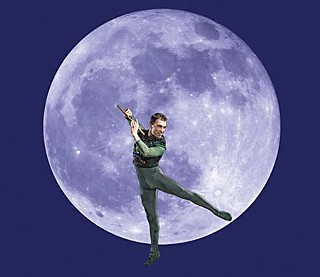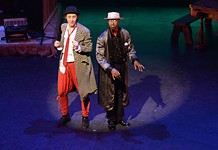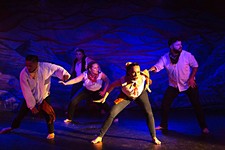The Magic Flute
This new balletic adaptation boasted fantastic visuals but stodgy choreography
Reviewed by Jonelle Seitz, Fri., May 13, 2011
The Magic Flute
Dell Hall at the Long Center, 701 W. Riverside
May 8
For his new ballet version of The Magic Flute, Stephen Mills rounded up shadow puppetry artists, a composition scholar to help him edit the opera score for ballet, and renowned costume and scene designers. While these elements resulted in a multifaceted production, the weaving of them was not always tight.
Mills partnered with folks from San Francisco's ShadowLight Productions to give the ballet a living backdrop. In shadow, entrances and exits were made, backstory was told, and drama was created. As the silhouette of a figure behind the backlit scrim grew larger or shrank smaller, levels were created without having performers climb on scaffolds or scenery, and scale became a dynamic element. Playing with scale on a stage with real people can be powerful, as anyone whose first memory of ballet is a growing Christmas tree in The Nutcracker can attest. In the final scene, a beheading was shown in silhouette, wonderfully clearly, with just a touch of gore, and in shadow, the event was remote enough not to frighten the small children in the audience.
Costumes by Susan Branch Towne were at times wonderful, especially the birds' tutus (she accentuated the duck-butt quality of the standard tutu by charmingly flipping them up in the back), the animals' headpieces, and understated, safari-styled outfits. Papageno and Papagena wore zany avian-inspired outfits that also seemed rich and complete. But the intention of the outfits for the three boy-spirits (who were men – more about that in a bit) was less clear. In bright-blue and green spandex shorts, they looked to me like bicyclists taking a break en route.
While much of the ballet clipped along at an audience-friendly pace, the show lagged whenever the chorus of priests, in their placid white robes, took the stage – how slowly they seemed to move and with what little purpose! Another problem was the casting of grown men as the prophetic, guardian child-spirits. Company men Ian J. Bethany, Jordan Moser, and Preston Andrew Patterson are members of that club of male ballet dancers who are technically very good but not tall enough to dance leading classical roles, so they are usually typecast in virtuosic second-string solos (for example, the court jesters in Swan Lake and Romeo and Juliet). Bethany, Moser, and Patterson are among the technically strongest men on Ballet Austin's roster, and it's understandable that Mills would create an opportunity to show them off. However, small or not, men don't have the mystical quality of children. Add to that the bike shorts and the virtuosic but not transcendent steps they were given, plus the conflicting qualities of this strange role (by being cast as children, they are emasculated, but the strength and height of their jumps and clarity of their beats imparted undeniable masculinity), and the child-spirit character suffered greatly.
While the cast for the rest of the ballet made more sense, with the lyrical Ashley Lynn Gilfix as Pamina, Frank Shott as Tamino, and Beth Terwilleger and Christopher Swain as Papagena and Papageno, the choreography was rather bland. In many of his abstract ballets, Mills layers responses to music and invents movement languages using the balletic body, but as with story ballets like his Nutcracker and Cinderella, the movement in The Magic Flute is conventional. The comic moments, like the spritely, perfectly timed little dance executed by Monostatos and his men when they are charmed by the magic bells, are the exceptions. Mills has a proven talent for comedy, and the jokes seem to have been given special attention, perhaps out of the need for precision to pull them off.
The stodgy choreographic style may be a response to a perceived traditionalist audience – the company's performance was marketed as a Mother's Day event. And maybe Mills sought to make the choreography somewhat easy to experience, given the other elements that this production requires the audience to wrap its collective head around, including the many-charactered story. It's also possible that Mills was under artistic constraints to make the ballet easily sellable to other companies. But should choreography come second to the production itself? The Magic Flute seems like it would have been the perfect opportunity to develop new movements to illuminate an old story.











